My Scuba Diving Journey
My interest in scuba diving began in 2018 on a dive near Sindhudurg, Maharashtra, organized by my friend Manali—undoubtedly the best trip planner ever. As part of the itinerary, we visited Devgad and found a place offering “fun dives for beginners”. Fun? Sure. Prepared? Absolutely not. Armed with nothing but enthusiasm, we jumped in—no suits, no fins, and frankly, no clue.
Though we managed to spot some marine life, the underwater visibility was poor – akin to pond water. At the time, I assumed this was the pinnacle of scuba diving. Spoiler alert: it wasn’t. Still, that murky adventure planted the seed for my love of underwater exploration.

My second “dive” was in Goa, where I learned that fish apparently don’t show up unless there’s a buffet involved. The dive instructor sprinkled some snacks into the water to lure the fish – imagine an ocean of breadcrumbs. They charged me 3k for a full day of activities, including this “dive”, but before I could even admire the underwater world, someone grabbed my tank like I was being evicted from the ocean. Honestly, I spent more time putting on the gear than actually diving!
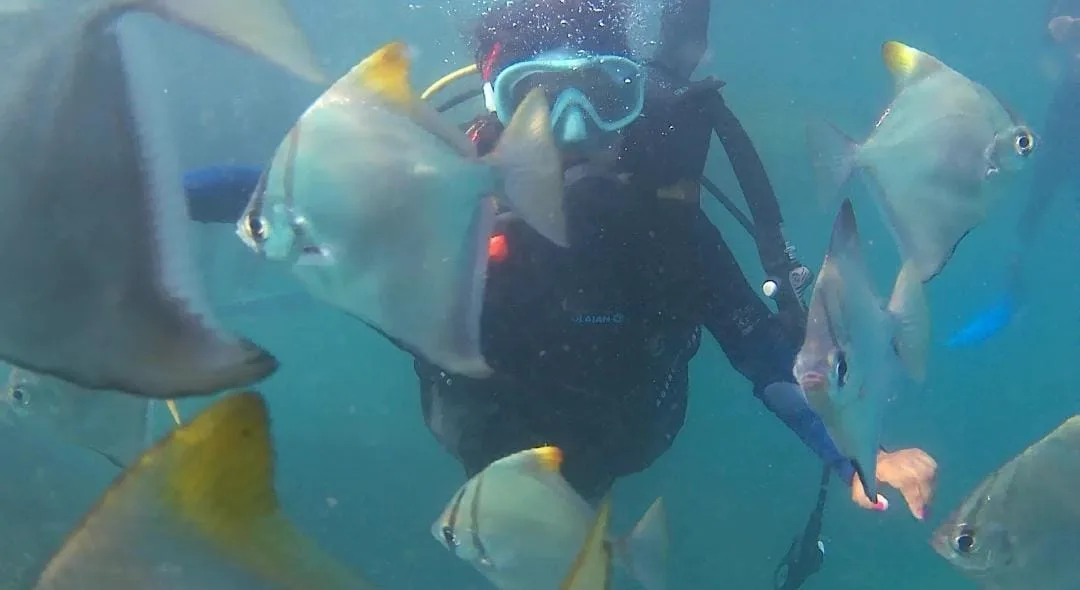
My third dive was where I finally got a taste of what scuba diving is actually supposed to be. I took a half-day, Discover Scuba Diving (DSD) course in Kovalam, where the visibility was good, with many colorful fishes. We started with training in confined water before heading to open water dives, all under the watchful eye of a skilled and professional dive master. I learned a few of the technical stuff—how to use the BCD, eye mask, tanks and regulators.

This experience really piqued my curiosity, and I went on a scuba-diving video binge. My friend, Doctor Chithartha (whose hobby is breaking bones but his day job is fixing them), was diving in the Maldives for his advanced diving course and posting videos in which he spotted loads of fish, including my all-time favourite—clownfish, a.k.a. Nemo. Watching his adventures was both inspiring and slightly depressing since my fish stories involved breadcrumbs and murky water.
Ever since that experience, I was itching to do a proper scuba diving course and dive deeper (pun intended) into the technical stuff. My partner for this mission was my swim buddy Kritika—a one-woman army. Initially, we had plans to take a course in the Andamans, but we eventually switched to a more budget-friendly option with NIMAS (National Institute of Mountaineering and Adventure Sports), and as it turned out, it was an amazing experience!
Registration and Course Details
The Basic Scuba Diving Course happens in the beautiful Dawki River in Meghalaya. You can book your seat on the NIMAS website, with courses available in February and November. Each batch has only 10 seats, and they fill up fast! For my course in November, I booked in May and that was the last seat.
You’ll need a medical certificate. Download it, fill it out, and upload it during registration—or email it later. Then just sit tight, and you’ll receive all the course details 45 days before the start date.
But to help you prepare even earlier, here’s a sneak peek at some of the important details you’ll find in the course document,
- Eligibility. Physically and mentally fit. The trainee should be able to swim a minimum of 50 meters and should not have undergone any major surgery or suffering from seizures, high blood pressure, heart-related diseases, fractures, or ligament tears of the knee, ankle, and shoulder.
- Suggested list of items required to be carried by trainee:
- Personal Equipment/Clothings:
- Undergarment sets – As required
- Good quality Rain Coat / Poncho – One (Mandatory)
- LED Head Torch with spare cells – One with a spare battery
- Writing materials and ballpoint pen – As required
- Toilet requisites – As required
- Gloves – One pair
- Warm shirt full sleeves and trousers – Two Sets
- Woollen pullover full sleeves – Two Sets
- Repair kit i.e. needle, thread, and buttons- As required
- Track Suit – One
- Good quality Sports Shoes – One pair
- Swimming Costume – At least one pair, though it’s a good idea to bring more
- Sunscreen – Carry only reef-safe sunscreen, as regular sunscreens can harm marine life and damage coral reefs
- Lunch Box, Glass, Spoon, and Water Bottle
- Documents:
- Latest Medical Certificate (Not more than two months old)
- Copy of Aadhar Card (It is mandatory)
- Copy of Bank Receipt of course fee payment
- Five passport-size photographs
- Personal Equipment/Clothings:
Note that your specific course document may vary slightly.

If you’re flying home afterward, remember to wait at least 24 hours after the course ends before boarding your flight to avoid decompression sickness (DCS). My course ran from November 9th to 13th. We arrived at the NIMAS centre on the evening of November 8th and left on the morning of the 14th. NIMAS provided accommodation and meals for the entire duration. We were assigned two rooms—one for the five girls and another for the five guys.
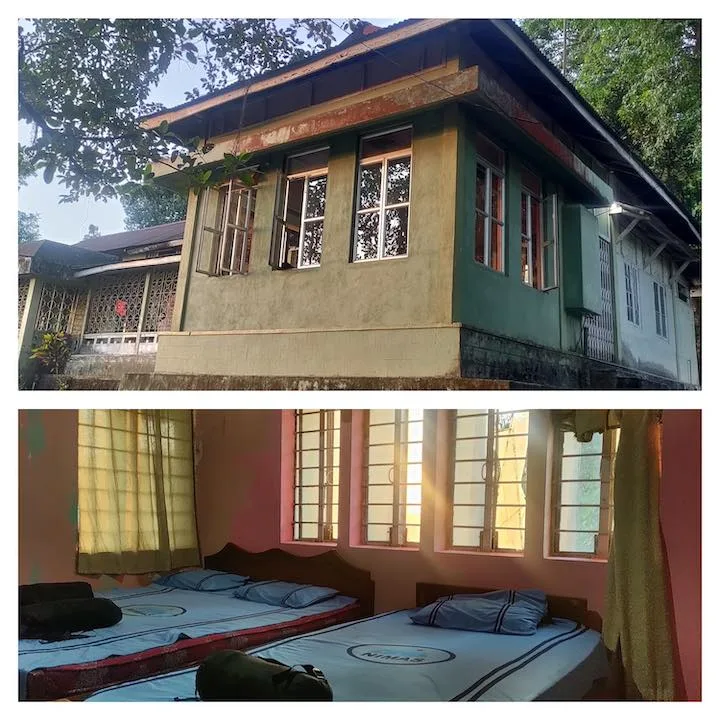

Scenic Spots En Route to Dawki
Local taxis are abundantly available in Shillong to Dawki, and they charge around ₹2000 to ₹3000 for a full day. We booked one and made a little adventure out of it before heading to the NIMAS centre in the evening for the course. Along the way, we visited two incredible spots:
Single-Decker Living Root Bridge, Riwai Village
It’s a bridge made entirely of living tree roots, carefully woven over decades by the local Khasi people. These bridges were created as a solution to the frequent damage to man-made bridges due to the heavy rainfall in the Cherrapunji region. Estimated to be at least 100–200 years old, living root bridges are formed by guiding the aerial roots of rubber trees across rivers or streams. They take decades to grow and strengthen, becoming sturdier with time and lasting for centuries.

Mawlynnong Village: Asia’s Cleanest Village
Mawlynnong village is a serene paradise with spotless streets, bamboo dustbins at every corner, and vibrant flowers lining the pathways. Awarded for its eco-tourism efforts, the village offers a glimpse of sustainable living, with homes powered by solar energy and compost pits for waste. Mawlynnong also boasts an impressive literacy rate of nearly 100%. Education is highly valued in the village, with most residents fluent in both Khasi and English.
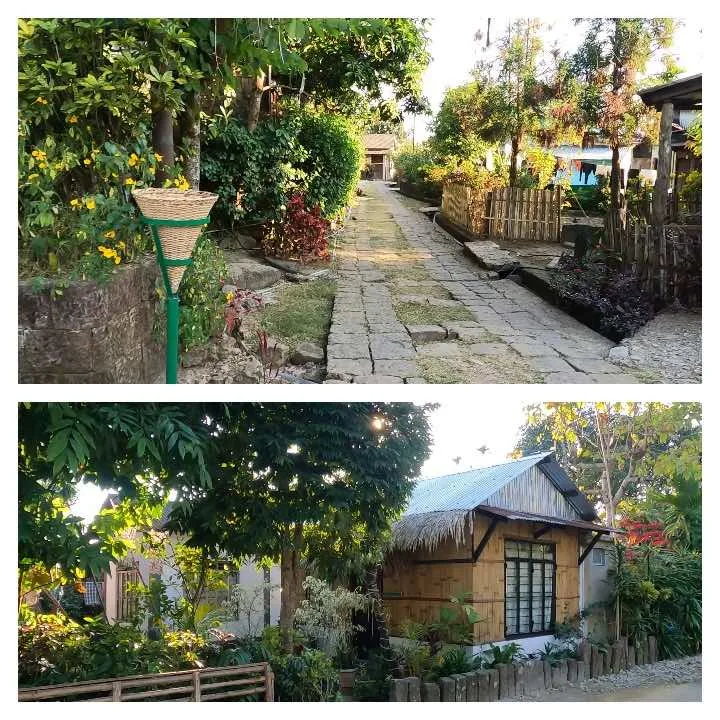

After this picturesque detour, we finally made our way to the NIMAS centre in Dawki, ready to dive into the course—literally and figuratively!
Day 1 Activities at NIMAS
Our team consisted of five instructors: Somir Basumatary Sir, Raja Basumatary Sir, Arjun Sir, UD Sir, and NA Sir. My coursemates came from various parts of India, including Karnataka, Tripura (me), Arunachal Pradesh, Meghalaya, Delhi, and Odisha, a true melting pot of cultures and personalities.
We had the gang from Namma Bengaluru, Bahubali from Delhi, a forever hungry soul from Tripura, always on the hunt for non-veg delicacies, a cool kid from Arunachal with chill vibes, adding beauty with brains was a talented doctor who doubled as our reel producer on the last day, and a YouTuber from Odisha, filming his first video, who always had a GoPro ready.

This is how we spent Day 1,
- Morning Routine
- The day began at 6 AM with a warm cup of tea, followed by a walk at 7 AM and breakfast at 8 AM.
- At around 9 AM we reached the dive site. We started things off with a ceremonial puja, followed by a routine blood pressure check.

- Water Activities in the Dawki River
- We were tested on our swimming skills, focusing on the front stroke and backstroke techniques. After the swimming test, we practiced snorkeling to get comfortable with basic water skills. We also did an optional cliff jump. While it wasn’t mandatory, all of us took the leap—literally.

- We were tested on our swimming skills, focusing on the front stroke and backstroke techniques. After the swimming test, we practiced snorkeling to get comfortable with basic water skills. We also did an optional cliff jump. While it wasn’t mandatory, all of us took the leap—literally.
- Gear Fitting & Lunch Break
- We tried on masks, fins, shoes, and dive suits to ensure everything fit perfectly for the upcoming dives. Quickly getting into the dive suit is an essential skill to master!

- We returned to the hostel by 1:30 PM for a well-deserved lunch.
- We tried on masks, fins, shoes, and dive suits to ensure everything fit perfectly for the upcoming dives. Quickly getting into the dive suit is an essential skill to master!
- Scuba Diving Theory
- Post-lunch, we watched an informative video about scuba diving for a few hours, followed by a group discussion to clarify concepts.
- The day ended with dinner, giving us a chance to unwind and prepare for the next day.
What You’ll Learn
Here’s a list of practical and theoretical skills you’ll learn. Note that this list is not comprehensive, as there were many other things we learned throughout the course.
- Practical skills
- Underwater Skills: Breathing techniques, hand signals, and equalization.
- Mask Skills: Half-mask and full-mask clearing to handle water leaks confidently.
- Buoyancy Control: Techniques for maintaining balance underwater, including proper finning.
- Equipment Handling: Assembling and disassembling gear, air checks, and inflating/deflating gear (both manually and with a button).
- Emergency Procedures: Regulator recovery, using an alternative air source, Controlled Emergency Swimming Ascent (CESA), and buddy checks.
- Safe Diving Practices: Controlled descents and ascents, and emergency swimming ascent techniques, along with surface protocols.

- Theoretical knowledge
- Diving Equipment: Dive suits, tanks, and gear essentials.
- Diving Safety: Decompression Sickness (DCS), Decompression Illness (DCI), emergency ascents, safety stops, and precautions.
- Dive Planning: How to plan a dive, including the use of the RDP (Recreational Dive Planner) table.
- Types of Diving: Understanding the different types of diving, from recreational to technical.
- General diving advice: Always dive with a buddy.

Days 2 to 5: The Daily Dive Routine
Our schedule for Days 2 to 5 followed a structured and well-organized routine to balance physical preparation, dive practice, and theory sessions. Here’s how it went:
- Morning Routine
- 5:30 AM: Wake up and get ready for the day.
- 6:00 AM: Tea to kickstart the morning.
- 7:00 AM: A refreshing walk, jog, and stretching session to loosen up.

- 8:00 AM: Breakfast to fuel up for the day ahead.
- Dive Practice
- By 9:00 AM, we reached the dive site and practiced scuba diving skills until lunchtime. These sessions were hands-on with plenty of time to build confidence underwater.

- After the practice, we returned to the hostel for lunch and some rest.
- By 9:00 AM, we reached the dive site and practiced scuba diving skills until lunchtime. These sessions were hands-on with plenty of time to build confidence underwater.
- Evening Theory Sessions
- At 5:30 PM, we had theory sessions where we learned the technical aspects of diving. These were engaging, and interactive, and helped connect the dots between practice and theory.
- Dinner and Wind Down
- By 8:00 PM, dinner was served, followed by a quiet evening to relax and prepare for the next day.
On days 3 and 4, we had knowledge review sessions, where we answered question papers, discussed them in detail, and cleared all our doubts with the instructors.
On day 5, we skipped the morning walk as we focused on preparing for and taking the written test, followed by a final assessment and feedback session to wrap up the course.
The last day at NIMAS was a mix of celebration and nostalgia. We were treated to sweets and watched a heartwarming video montage of our journey through the course. This was followed by a thank-you session and plenty of photos to capture the memories. The next morning, with goodbyes and promises to stay in touch, we bid farewell to NIMAS and set off on our post-course adventures.

Post-Course Adventures
On our journey back from NIMAS to Shillong, we visited three incredible places:
Phe Phe Falls
The name “Phe Phe” comes from the local Khasi language, where “Phe” means “paradise” or “heaven.” It’s a stunning multi-tiered waterfall surrounded by lush greenery with a clear, pristine pool at the base.

Krang Suri Falls
Located in Jaintia hills, Krang Suri is a stunning waterfall with crystal clear blue water.

Nartiang Durga Temple
Nartiang Durga Temple is a 600-year-old temple located in the West Jaintia Hills. It is one of the 51 Shakti Peethas and is one of the holiest sites for devotees of Hinduism. It is believed that Sati Devi’s left thigh had fallen there.
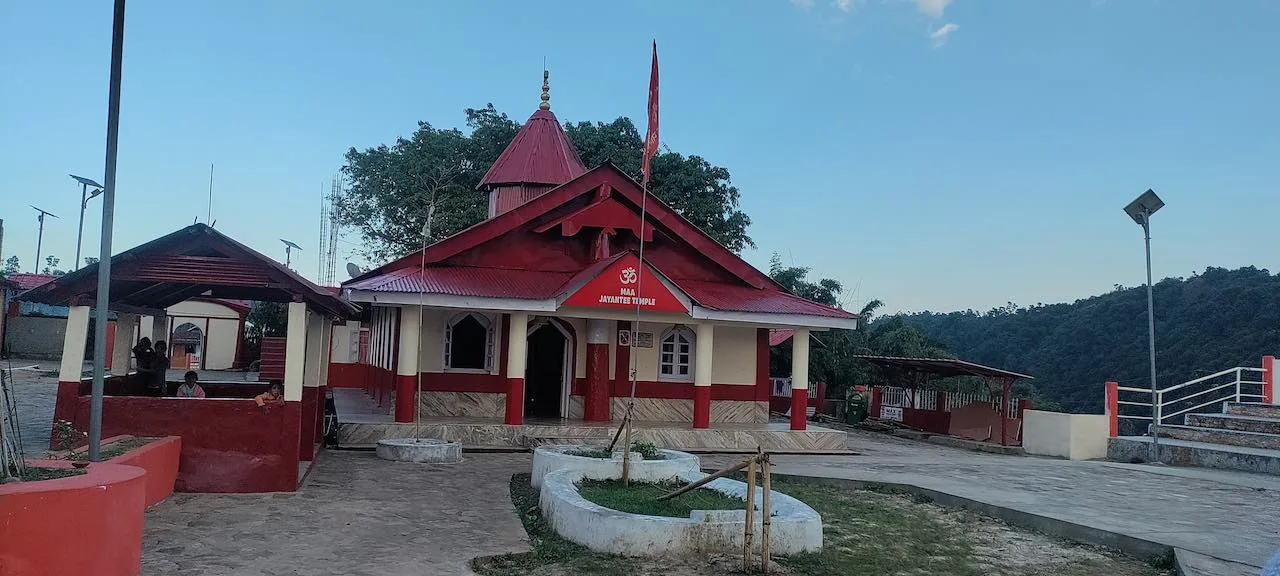
Nearby is the Nartiang Monoliths, a stunning collection of ancient stone structures. Believed to have been erected between the 16th and 17th centuries during the reign of the Jaintia kings, these monoliths were placed to honor warriors, celebrate victories, and mark significant events. This site is one of the largest collections of monoliths in the world.

FAQs
Thanks for reading! If you have any questions, please don’t hesitate to leave a comment below. We’ll get back to you as soon as possible.
The world’s finest wilderness lies beneath the waves
Robert Wyland







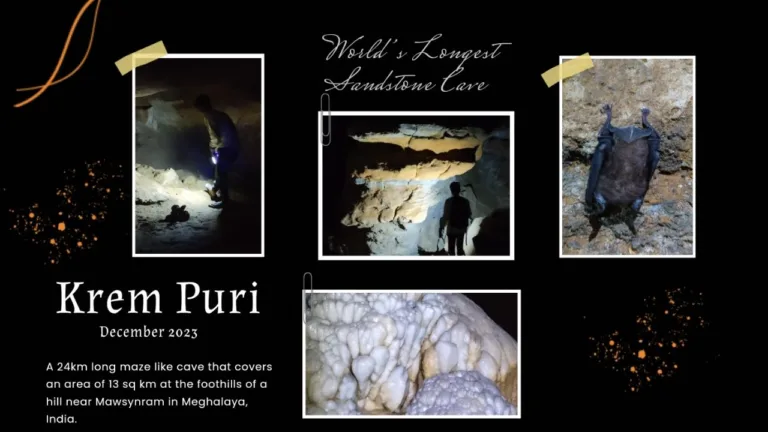
Wonderfully penned!!!
Glad you liked it!
Excellent information👍👍
Thanks for reading!
Awesomely captured.!
Thank you!
Wooohoooo
Proud of you 👍
Thank you!
Khub bhalo hoyache